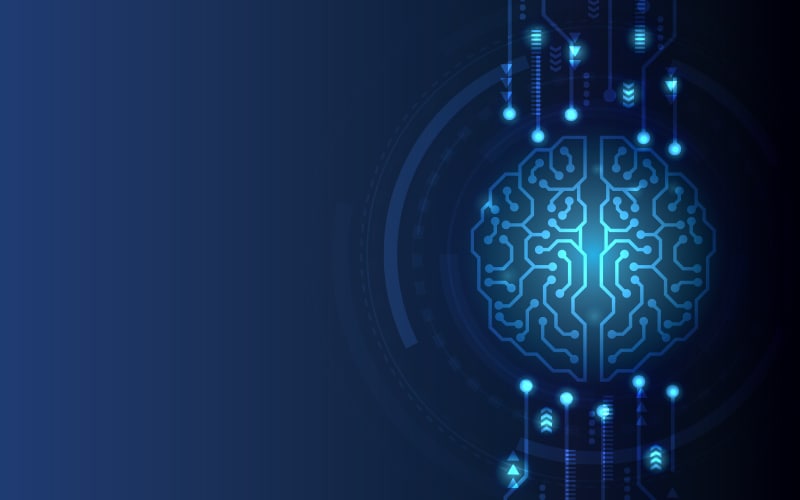We find ourselves living in times that are no less than revolutionary and driven by digital, transforming the way business is done. Enterprises need to pivot to accommodate and respond to the market shifts around trust, AI and customer revolutions. Infosys leveraged this platform to highlight our approach to these market shifts through our theme of “Amplify Experience with Live Enterprise.”
Infosys and Salesforce are committed to helping clients explore our innovative solutions that will help amplify the experience for their customers, employees and partners. We do this by providing a fresh perspective and showcasing industry-leading next-gen solutions, such as auto-remarketing, Efficient 360, and customer advocacy.
Our experts showcased client success and our transformation throughout breakout sessions, mini sessions and roundtables. Salesforce experts highlighted capabilities around business strategy, consulting services, and implementation services across the Salesforce ecosystem. We hosted panels on multiple topics, from auto-remarketing solutions to how intelligent service is changing the game as companies launch into servitization. These panels validated strategic discussions of elevating the customer experience. One conference session discussed ways of leveraging blockchain as a solution to a health cloud to significantly reduce the onboarding process for providers. This year’s Dreamforce journey included prominent people speaking on world-class leadership. Former president Barack Obama sat down with Marc Benioff and delivered inspiring words on leadership skills he learned while in the White House, training the next generation of leaders , and the importance of being kind and useful. During a fireside chat, Apple CEO Tim Cook discussed environmental efforts and designing privacy. Soccer legends David Beckham and Megan Rapinoe also held a session, along with notable actors, world leaders, and leaders in large corporations. Dreamforce 2019 hosted more than 2,700 sessions, 37,000 exhibitors, and speakers from all over the world. Dreamforce exemplified diversity and learning in action. For Infosys, the event was a great success thanks to our panelists, our clients, and many Infoscions who worked hard to share their insights. In this journal, we share highlights from our Dreamforce sessions and hope they provide you with perspective and value in your own learning and transformation journey.
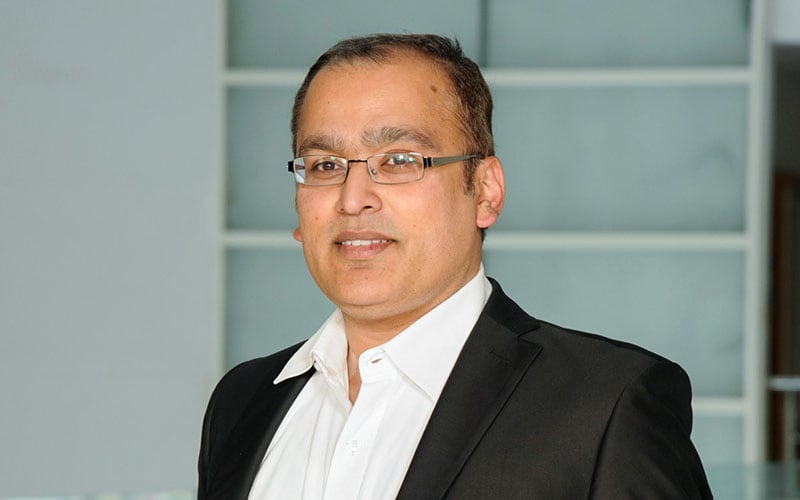
Indranil Mukherjee
Senior Vice President, Salesforce Practice Head, Infosys
REINVENTING LEARNING IN THE ERA OF INDUSTRY 4.0
The current talent famine is not just a problem for the digital world but a concern everywhere, including academia.
Salesforce predicts that the tech industry will need 250,000 new consultants in the next five years. A company survey shows that 70% of large corporations do not believe they are ready to digitally transform based on the existing talent pool.
The numbers are daunting in the tech world, but leaders are starting to discover ways to close that gap. During a panel discussion at Dreamforce, educators and business leaders discussed how they are actively approaching these challenges. It starts with companies exploring how to reinvent learning. Leaders are looking closely at the future of their workforces, how they are evolving and how their companies can collaborate with universities.
“One of the major roadblocks that we see, essentially, is the lack of digital skills. And that is preventing corporations from meeting some of their objectives,” said Indranil Mukherjee, senior vice president and Salesforce practice head at Infosys.
One factor driving this trend is the evolution of technology, which is moving fast and making some elements obsolete quickly. According to Sonia Cardenas, vice president of academic affairs at Trinity College in Hartford, Connecticut, technology evolution is creating a significant skills gap between digital technology and human-centered skills.
“It’s something that we’re all confronting in higher education and trying to address at the same time,” she said. “We need a niche talent pool that bridges the gaps between digital skills and more human-centered skills and between overspecialization and more broad-based approaches to thinking.”
So, how can higher education help move students into the tech space when students may not feel they fit into that space?
“One of our most important jobs is to teach our students the fundamentals,” said Ranavir Bose, director of the Center for Information Technology and Management at the University of Texas at Dallas. He reminded the audience that everyone will have to learn to change, pivot and adjust to new technology.
As schools guide students toward technology and collaborative skills, large corporations are also addressing these challenges.
“The winners and the successful companies today take a very holistic approach to employee development in the sense that mentoring starts from the beginning of the employee’s career in the company and [continues] throughout the journey,” said Kai Makela, CEO of Fluido, an Infosys company based in Helsinki. He explained that both parties must see the learning opportunities and benefits of a partnership. Without that understanding, Makela said, “companies want to go somewhere and then the employees want to go elsewhere.”
Cardenas believes all sides must think of this broad-based approach and mix intentional learning with lifelong learning.
“Companies need to be strategic and intentional about how they’re instilling lifelong learning in their employees,” she said. “I think it’s worth noting again, maybe from an academic perspective, that we need to think about lifelong learning not just as reskilling … but also [as] instilling habits of mind and intellectual curiosity and wanting to learn.”
Academia recognizes that students have a need for hands-on, experiential learning. The traditional classroom or lecture hall isn’t enough.
“To execute something like that in a university setting is a little bit more complicated,” Bose said. “We are working with influencers and other companies on ways to address the problem.”
Makela agreed with that assessment.
“We have had very good experiences with students entering the last semester, approaching us as interns,” he said. “You get to learn [about] those students as individuals and people. They get to learn about us, the platform and the things we work on.”
As companies look to create a path for future employees, an internship is an avenue for businesses and colleges to partner. For this to work, the goals of the student and company have to line up. There also has to be a way to measure success.

“If they are learning new things and having opportunities that they wouldn’t otherwise have, that’s the No. 1 measure of success.”
The panelists agreed that another successful strategy is nurturing relationships with the universities, appearing on campus and sponsoring projects.
Infosys took this path when it invested in Trinity College. School and company leadership created a partnership to bridge the gap between liberal arts and digital technology. The eight-week program focuses on soft skills like communications and leadership.
“The first five weeks, we deliver a combination of design thinking, business analysis and liberal arts skills,” Cardenas said. “Our goal is recruiting and building a pipeline from selective liberal arts colleges across the country and training students from all sorts of majors. Their majors may not be technical.”
Even students with technical backgrounds are taught additional business and other skills they need to thrive, she said. Students also spend three weeks working on foundational technology from Infosys and industry-specific knowledge. These are people who are planning to work in business analysis or consulting.
“It’s an amazing opportunity for all of us,” Makela said, “including our customers and business interests, coming from both the consulting and teaching perspectives.”
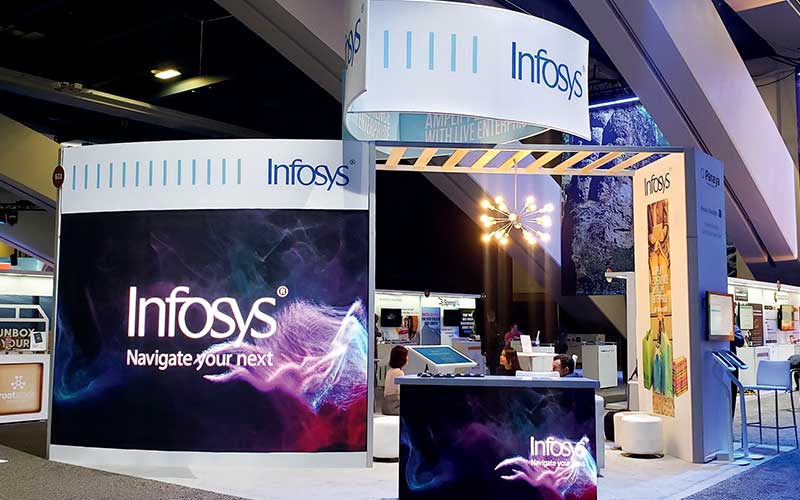
CUSTOMER 360, MEET AGENT 180
Is it possible to make an agent a customer mind-reader? That was what leaders of a global electrical component manufacturer wanted to accomplish through a case study they described at the conference. These leaders believed that by providing the best possible customer service, they could increase sales of high-margin products. The Infosys team was asked to create prototypes and designs to test the concept. It turned out that about half to the “Customer 360” data was useful, resulting in an informal name for the project “Agent 180.”
If a customer called the day after a shipment was due, this was the likely reason for their call. The project goal was to pre-populate the Salesforce Lightning Service Console (Agent Console) with data on the late shipment and anything else the agent might need to resolve the problem.
Late quotes were another example where it was possible to use Customer 360 data to predict why the customer was calling, emailing or texting. Other examples required sophisticated statistical analysis and artificial intelligence (AI) as Cal Smith, Infosys technical architect, describes below.
The team started by installing tools to improve how an agent relates to customers before the conversation starts. Speed was the essential constraint. Agents had only 20 seconds to answer the phone or start a chat. This was a potential “project killer.” If the integrations caused a response time greater than 20 seconds, the whole effort was a failure.
Other early steps including defining the sources of data, which included Salesforce, SAP, MuleSoft integrations and the company’s data warehouse. Each offered a small but important piece of the puzzle. The data and analysis would enable service agents to quickly respond to customer inquiries.
The team needed to determine the workload of 125 to 150 customer service agents in order to prioritize development. The customer care agent’s workload was 60% email, while product specialists handling small customers spent 60% of their time on online chats. The inside sales agents were on the phone 40% of the time, often cold calling.

“The product specialist agent emerged as the user that could most benefit from the Agent 180 system. This was a bit of a breakthrough because it allowed us to focus our efforts on just one persona [type of user].”
Schedule changes, changes to order item quantities or parts numbers also emerged as predictable call reasons but required more advanced analysis and techniques (Statistical Analysis, AI, Technical Details).
Three prototype demos were delivered to the client.
The first one demonstrated the key capability of identifying the contact on incoming calls or chats and pre-populating the Agent Console. The second prototype added the ability to populate meaningful data in the Agent Console to help with the case.
With prototype three, Ingram said, the test agents were provided predictive information almost immediately. Within 20 seconds, the system could, for example, indicate to the agent an “87% likelihood the quote is overdue. That’s why the customer’s calling.”
That last prototype was the payoff - the mission was accomplished. The team demonstrated that it was possible to present the agent with the likelihood that a customer was calling for a specific reason and populate data in the Agent Console. The agent would appear to read the customer’s mind – within 20 seconds. By providing exceptional customer service, the agent could move on to selling high margin products immediately – in the same call.
“They [the company] talked earlier about SAP being one of the primary sources of data that wasn’t in Salesforce,” said Calvin Smith, a technical architect at Infosys. “This particular company did all of their quotes in another app that wasn’t in Salesforce, and they were working with MuleSoft to bring those quotes into Salesforce.”
That approach did not work well because updates took too long. Instead, they needed to combine the SAP and Salesforce data, send it through AI processing, and forward the AI analysis results to the agents.
The statistical analysis and AI required for making sense of hundreds of thousands of orders and millions of line items were not easy.
“It begins with the frequency and distribution of how these issues occur, the things that you’re trying to predict,” Smith said. “If you have one issue that is a whole lot larger than your other issues, trying to predict those secondary issues becomes extremely challenging. The data is almost meaningless for the secondary issues.”
“The predictable items must have similar scale and variance,” Smith said.
This requires data results that are close to the final measurements for normal distribution. To achieve that, one must understand the nature of the data and look at the results in multiple spaces. This will allow users to make more accurate predictions.
When successful, the model will have data with a positive correlation in several items, including customer size, product category, customer industry, order size, customer location and number of products.
Even more important is validating the data to ensure it’s not skewed. That includes checking the responsiveness to see how quickly the model will learn. This checkup will also show the elasticity of several data source objects.
Programming the system also requires incorporating machine learning, a goal that can be accomplished in several different ways. The Einstein system is one way of doing this, by regularly refreshing data. Hence the system learns to process.
“My preferred method is to create an object for your predictions, which you then incorporate into your overall object model. That [object], initially, is not going to have any data,” Smith said.

“It ultimately is used to adjust the AI, and it becomes part of the predictions.”
“That is how the AI learns and creates a feedback loop that teaches the system. A refresh model is not needed in this method.”
AMPLIFYING EXPERIENCE: SUCCEEDING IN DYNAMIC B2B COMMUNICATIONS AND MEDIA
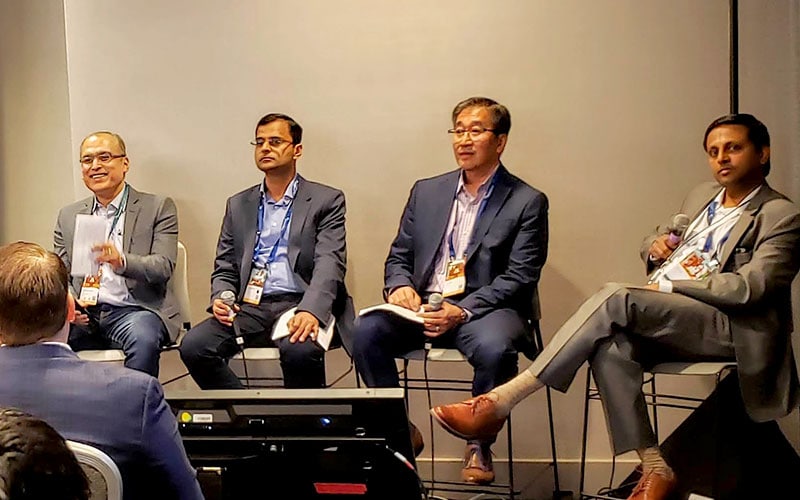
Communications and media companies are facing unprecedented industry disruption from new competition, such as over-the-top providers. Meanwhile, legacy systems and disjointed processes often create barriers to both business agility and innovation for established firms.
“The telecommunications industry is hugely being disrupted by the new age players, the OTT (over-the-top) players,” said Indranil Mukherjee, senior vice president and Salesforce practice head at Infosys. “Telecommunications companies have a legacy landscape, which is hampering their speed to business, which is hampering their rate of innovation, which is happening because of the disjointed business processes.”
To compete, leading communications providers are transforming their B2B companies with new business models that elevate partner and customer experiences. Companies are often using systems like Salesforce and the ISP ecosystem to fuel their transformations.
“I look at Salesforce as the enabler, the platform,” said Anand Narasimhan, chief customer architect of Salesforce. “B2B customers are demanding consumer experiences. They are using us as platform enablers, whether that involves the customers building their solutions on top of our enabling platforms or accelerating some of that digitization.”
U.S.-based Verizon and Australia-based Telstra are two large telecom companies using this approach as part of their transformations. The customer-centric goals include simplifying processes and creating service agility and flexibility for partners.
Verizon wanted to create a customer-focused experience as it digitally transformed its wholesale division. Executives in specific parts of the company’s multinational telecommunications conglomerate realized their industry was becoming commoditized. Verizon was not able to satisfy its large customers due to silos, inefficient legacy networks and some complex issues. Those issues included problems centered on company growth without adjustments to customers’ needs. For example, customers would receive quotes from one system, order from another, and use a third to complete the process.
Verizon’s leaders acknowledged that they needed to make some changes and that it was time to make the customer experience a differentiator from other organizations during the digital transformation. They focused on two areas: the portal experience and a consistent application program interface experience.
“We had a design-thinking approach,” said Wayne Chang, IT director at Verizon. “We had to learn about the customers. The voice of the customer is vital. We got their point of view.”
The next steps in improving the experience involved brainstorming sessions, building prototypes and gathering customer feedback, Chang said. That included more than 28 boot camps during a 12-month period. “We’ve had over 1,500 user stories that we’ve had to develop with our business partners,” he said. “We’ve completed over 1,500 designs, and our goal is to get about 10 products and 200 capabilities out there.”
While Verizon has completed about 50% of its goals, they know that the personal, intuitive and straightforward approach is working because the feedback is already moving in the right direction. According to Chang, “All that telco lingo, all the jargon that was out there, has been removed. It’s a lot more intuitive.”
From there, the company developed the API layer for internal use.
“Our APIs are consistent between the portals along with B2B APIs,” Chang said. “So it’s a consistent experience whether you’re coming in via APIs or through the portal. We enable a lot of different products across a lot of different networks. With that, we have a high-level timeline of what we’re introducing in terms of the functions and the capabilities.”
Overall, Verizon’s objectives were to reduce the complexities of doing business, overcome legacy system barriers and make the process seamless. Achieving those goals took nearly two years of research and included breaking down silos and viewing the process through the customers’ perspective.
Telstra, Australia’s largest mobile network provider, set objectives similar to Verizon’s in order to simplify the process for customers. Leaders were aware that modularizing products, such as enterprise mobile phones, unified communications and internet products, were keys to success.
Yeshwanth Tiwari, a strategic solution IT principal at Telstra, said his company viewed the experience from a customer angle, an employee angle and a partner angle.

“Customers want us to be flexible. The customer wants us to be very fast. Plus, they don’t want exposure to a lot of the complexities of our systems or the many touchpoints we have.”
Telstra has digitized a one-click quote-to-contract system by taking an end-to-end view of the program, from concept to market. Also, the partner portal used technologies such as Salesforce, CloudSense and Apttus to help meet digitization goals.
The main takeaways were for company leaders to listening to customers and the company putting its own reimagined view of the world along with the needs of the market. Salesforce officials said actions taken by Verizon and Telstra should be the standards for telecom companies.
“From a Salesforce perspective, they’re looking at us as platform enablers, whether that’s the customer building their solutions on top of our enabling platforms or accelerating some of that digitization through our ISP vendors such as Velocity and CloudSense,” Narasimhan said.
While there is no right or wrong answer in the telecom stack, a customer-centric approach is the benchmark for future success.
CREATING NEW REVENUE STREAMS WITH INTELLIGENT SERVICING AND SERVITIZATION
The manufacturing industry faces unprecedented commoditization, which has slashed margins and created opportunities for low-cost competitors. Even as this financial pressure builds, customers still expect superior service and outcomes.
These shifts in business, technology and customer expectations have led best-in-class manufacturers to seek new business models and nontraditional revenue opportunities. Leaders from 20 companies gathered at the InterContinental San Francisco for a roundtable discussion about how servitization can transform traditional manufacturers.
“We are seeing a lot of manufacturers looking to transition,” said Rajiv Puri, vice president of manufacturing partnerships and servitization at Infosys. “We are not leasing because there is a lot of commoditization pressure in the industry. And at the same time, product life cycles are becoming longer; products are becoming much more robust. So, selling new products is becoming more difficult.”
While traditional sales generate more money initially, Puri said that service revenue can keep paying off for 20 to 40 years. So, it’s imperative that manufacturers capture all that revenue stream rather than cede much of it to distributors or third-party service providers. The concept of servitization has been around for years, but it still faces challenges from the tradition-bound approaches and cultures at many organizations.
“This is not just about a new commission model; it’s about a new business model,” Puri said.
Finding value in the services offered is an important challenge, but it’s not the only one in the transition to servitization. Some organizations see service as a cost and not a sales lead. Plus, there are deep-rooted legacy systems and a reluctance to change. Whenever a company introduces new technology, leaders view the technology as a service technology of limitation rather than a shift in how to operate more efficiently. But it is a different model when the company goes the servitization route.
That change requires companies to better understand their customers’ decision-making and purchasing processes. Only then can organizations create long-term relationships, switching from providing products to providing services.
“That’s a challenge to get that sense of direction and responsibility and empowerment into the sales organization that has grown up selling in a very different way and with a very different product,” said Shanton Wilcox, a partner in high-tech manufacturing for Infosys Consulting.
The panelists emphasized that profits do not start when the equipment ships but 14 to 18 months later. Companies need to create relationships that facilitate cultural changes and create service leads and added sales. These are concepts that invest in the customer and in the manufacturer’s future.
Customers also experience a similar hesitation — or even unwillingness — to change.
“Part of it is changing the customer’s culture as well,” Wilcox said. “Part of it is also having the customer understand how you (the company) realize value and the role that the customer plays in their side of that service contract.”
He explained that developing a relationship with customers is crucial to overcoming obstacles in the sales process and sealing the deal.
“It is a different approach to the sale, and it is a different heartstring that you’re pulling on than a feature function sale,” Wilcox said. “When you do that, it’s making sure the customer understands the after-market services strategy.”
Once defined, an agreement can look like an extended warranty turned into an uptime contract and eventually a service agreement. The solution to understanding the value proposition is understanding the value the service brings and knowing the customer.
“You want to be a partner with the customers, not just in selling the product and service, but also in being a part of their business,” said Anubhaw Bhushan, a CRM director at Komatsu. “I think if they make money, we make money. If they don’t, we don’t.”
He said it was an eye-opening experience when his company helped its customers change to a more accepting culture.
“They probably will not embrace what we are trying to do here, but I think it comes down to what’s in it for them,” Bhushan said.

“The whole change management is so key to making an influential change in the culture.”
However, it’s not always the manufacturers leading these efforts. Some roundtable participants said their customers are demanding servitization. It is part of the cultural shift that both parties have to understand to move forward.
“Put your customer at the center,” Wilcox said. “Your customer actually doesn’t want you to drop off a really complicated product and say, ‘Good luck; work with that,’ and then go off to the next thing.”

HOW FINNAIR DELIVERS A NEXT GENERATION EXPERIENCE FOR ITS CUSTOMERS
In the competitive world of airlines, Finnair cannot remain still.
Officials at Finland’s largest airline decided they must create and deliver a more consistent and comprehensive experience for travelers. To be an industry leader, an intense customer focus was the only option.
Tuija Makkonen, head of Finnair’s customer experience applications, said her airline is investing heavily in personalization and customer experience. The objective is to make sure its nearly 12 million annual travelers have the services they need, when they need them.
“Personalization with AI [artificial intelligence] is one of our priorities,” she said. “We are looking forward to seeing how we can bring more.”
The airline has already connected with its customers through multiple channels, including email, social media, phone, the web and mobile apps. However, Finnair recognized that the company didn’t have a clear understanding of its relationship with its customers. And as one of Finland’s largest companies, corporate leaders determined they needed help improving the airline’s perception.
Makkonen said Finnair invited customers to review new products and also worked with external vendors to design new air travel services.
As part of this effort, the airline collaborated with Helsinki-based Fluido, an Infosys company focused exclusively on Salesforce technology. The result was a unified cloud solution that connects Finnair with their customers in a new way and delivers an end-to-end customer experience.
“On the claims management side, we’re running an automated case-handling process,” said Antti Turunen, chief marketing officer at Fluido. “We are bringing our claims and handling customer feedback, which is part of our global customer care, to Salesforce as the cloud, on the same engine.”
The new Salesforce projects have allowed Finnair to better communicate with travelers who have hearing loss. Also, the company created an app for its Asian market, where the airline has 19 destinations.
Makkonen said she’s proud of the progress made by her small team. Pulling together as one — and focusing on their goal — has led to success at one of the world’s oldest continuously operating airlines. Finnair was awarded a Five Star Global Airline Apex rating in 2019.

“The important point is loving the customer.”
“From the IT perspective, of course, for me it’s loving my business [and my] customers and thinking every time that the customer is in the center of everything that you do,” Makkonen said.
SOLVING THE PROVIDER DATA DILEMMA WITH SALESFORCE BLOCKCHAIN
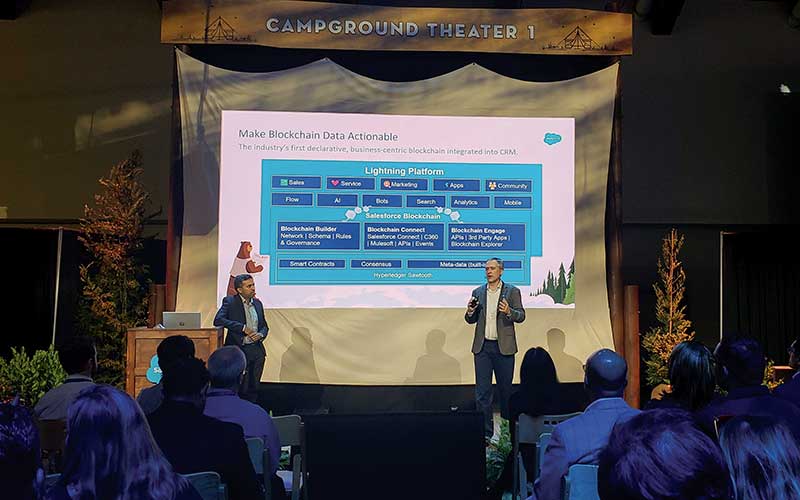
The same digital wave that created cryptocurrencies is now pushing the ever-changing health care industry into its next phase.
This change means that the term “provider” no longer references just physicians, clinics or health professionals. The change also means data management is better processed for providers. The industry is also shifting to value-based care and that requires new data challenges and the addition of blockchain technology. “We’re bringing you blockchain that is so easy to deploy that it will be democratized for all our customers,” said Dan Harrison, emerging technologies architect at Salesforce.
The blockchain technology, using Salesforce’s Lightning platform, is a database layering system that allows companies to more easily upgrade their capabilities. Clients can take their existing business process engines and enhance them with additional security provided by blockchain, without the need for custom code.
This gives patients more ownership of their own information and even allows them to control decryption fees associated with their accounts. And physicians and other health care providers are able to manage their professional data. The result is patient-owned data within a doctor-owned data system. Each party has the right to control who can access their private or professional information.
In the health care industry, this idea is revolutionary. Medical plans and payer organizations traditionally were unable to collect and evaluate information in an accurate and timely manner. Any inaccurate data on the provider side put patients at risk, and cost billions.
“[On] the payer side, 40% of the data about the doctors is either incorrect or it doesn’t even exist,” said Karthik Nagarajan, an industry principal at Infosys.
Blockchain creates a solution that faithfully preserves what doctors place in the system. It gives the provider a simplified user experience with application processes and easier credentialing verification.
“What you see in the data that we keep collecting from the blockchain is a timeline,” Nagarajan said. “As you start, somebody submits the provided application, it goes to manual verification and then the audit trail is started.”
The credentialing process sends information to various stakeholders who can confirm its accuracy and move the process forward. Each new task created is written on the blockchain. Data is presented in such a way that everyone has the same view of the provider’s credentials. There is also a system in place to eliminate the ability to delete data.
“That’s where the term blockchain comes together,” Harrison said. “Each one of those data blocks is chained together in such a way that you cannot modify any one part without breaking the whole chain.”
Credentials move with the medical professionals. Updates are completed just once — and transparently for everyone associated with those records. A signature is needed for verification and to double-check the information’s validity. Blockchain reduces a process that traditionally takes 120 days to a five-to-seven-day paperless process.
The experience simplifies the application and captures the process, contracting and credentialing on the Salesforce blockchain to reduce the onboarding time and capture accurate data on the doctor.
Provider Experience aims to simplify the contracting and credentialing process through Salesforce Blockchain. It enables us to reduce the onboarding time and know your doctor better.

